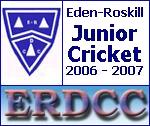Western Districts Schoolchildrens Cricket Association
PLAYING CONDITIONS—SENIOR 1 DAY
Eligibility
The Senior 1 Day Grade is open to teams consisting of any players (girls or boys) up to Form
II.
Competition Format
The season commences in February (normally the second weekend after schools open), and concludes
in December on the weekend before schools close.
Match Format
Matches are (one) 1 innings per team. Innings are limited by overs and time.
Each one (1) day match is of three (3) hours duration. Each innings has a maximum of 25 overs.
If twenty-five (25) overs have not been completed by the time to end the innings (see Compulsory
Declaration below), five (5) runs shall be added to the batting team’s score for each over not completed. This shall
apply for either weather delays or due to a slow over rate, but not if due to a team being late to commence the match.
Compulsory Declaration
The team that bats first shall have half the available playing time for its innings, at which
time it shall declare (allowing ten (10) minutes between innings).
If no time has been lost (e.g. weather, ground conditions) during this innings, the compulsory
declaration shall be at 10:25 a.m. (5:55 p.m. on Fridays). If any time has been lost prior to the declaration, the remaining
available time for the whole match is to be halved and a further adjustment made to allow for the ten (10) minutes between
innings.
The match must end at the end of the over being bowled at 12:00 noon (7:30 p.m. on Fridays).
Balls Per Over
There shall be six (6) balls per over.
Over Rate
The expected minimum over rate is eighteen (18) overs per hour. This has been set to encourage
fair play.
Pitch Length
The recommended length of pitches for Seniors is 20.12 metres.
Bowling Restrictions
It is desirable that all players be encouraged to bowl. In an effort to achieve this, no bowler
shall bowl more than 4 overs per spell.
Wides
If the bowler bowls the ball so high or so wide of the wicket that, in the opinion of the umpire
it passes out of reach of the striker standing in normal guard position, the umpire shall call and signal "wide ball" as soon as it has passed the line of the striker’s wicket and an extra ball bowled.
The umpire shall not adjudge a ball as being wide if:
a) the striker, by moving from his guard position causes the ball to pass out of his reach.
b) the striker moves and thus brings the ball within his reach.
NOTE: This is the law in ordinary cricket. The TV one day rule for leg side or height does not apply.
No Balls
The ordinary law applies. No balls shall be called, and an extra ball bowled. No balls shall
be called if:
a) A full pitched ball passes above the batsman’s hip
b) The ball bounces above shoulder height
LBW
The ordinary law applies. Umpires are expected to apply the law correctly. In particular if
in doubt, not out.
As a guide, if the ball strikes the player in front of the crease, it is unlikely that you would
know whether the ball would have hit the stumps. Remember a batsman cannot be given out if the ball pitches outside the leg
stump.
For all LBW decisions, the umpires name is recorded on the results sheet.
10 Metre Rule (Fielding Restriction)
The ONLY players allowed within ten (10) metres of the in-strike batsman are the wicket keeper
and slips fielders. (This is a NZ Cricket Council recommendation for Under 16 grades and below.)
This rule is to be STRICTLY OBSERVED in the interests of safety for the children.
Retired Batsmen
The ordinary law applies. A batsman retired hurt may resume his innings at the fall of a wicket.
No other retired batsman is entitled to resume. However, the fielding side is encouraged to invite a retired player to resume,
especially if retired to enable other team members to get a bat.
12th Man/Replacement of Players
A 12th man may be used as a substitute fielder. Batting teams are encouraged to allow the 12th
man to bowl.
Determination of Result
Win:
The team with the higher score, regardless of wickets lost is the winner.
Tie:
If the score is exactly tied at the end of the match (regardless of the number of wickets lost
by either team), the result is a tie.
Points
Win 5 points
Tie 3 points each
Loss 0 points
Drinks Intervals
A drinks interval may be taken in each innings, at intervals not less than 40 minutes. (It is
recommended that these be every 45 minutes.)
A change of inning shall be counted as a drinks interval.
Drinks must not take more than 5 minutes from the end of one over to the commencement of the
next.

